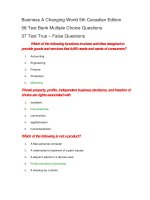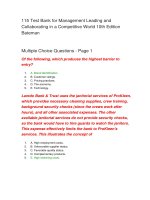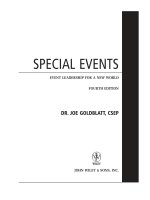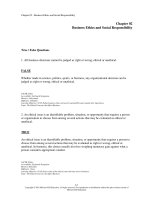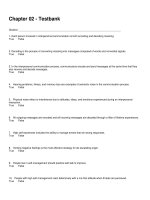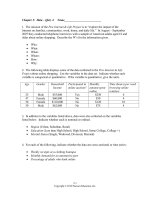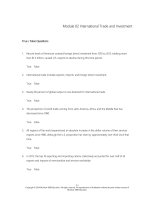Test bank business communication developing leaders for a networked world 2nd edition
Bạn đang xem bản rút gọn của tài liệu. Xem và tải ngay bản đầy đủ của tài liệu tại đây (641.19 KB, 65 trang )
Business Communication Developing Leaders for a Networked
World 2nd Edition Test Bank by Peter Cardon
True / False Questions
3-1
1.
Each person involved in interpersonal communication is both encoding and decoding
meaning.
TRUE
Each person involved in interpersonal communication is both encoding and decoding
meaning. It involves the exchange of simultaneous and mutual messages to share and
negotiate meaning between those involved.
AACSB: Communication
Accessibility: Keyboard Navigation
Blooms: Remember
Difficulty: 1 Easy
Learning Objective: 02-01 Describe the interpersonal communication process and barriers to effective communication.
Topic: Understanding the Interpersonal Communication Process
2.
Decoding is the process of converting meaning into messages composed of words and
nonverbal signals.
FALSE
Encoding is the process of converting meaning into messages composed of words and
nonverbal signals. Decoding is the process of interpreting messages from others into
meaning.
AACSB: Communication
Accessibility: Keyboard Navigation
Blooms: Remember
Difficulty: 1 Easy
Learning Objective: 02-01 Describe the interpersonal communication process and barriers to effective communication.
Topic: Understanding the Interpersonal Communication Process
3-2
3.
In the interpersonal communication process, communicators encode and send messages at
the same time that they also receive and decode messages.
TRUE
In the interpersonal communication process, communicators encode and send messages at
the same time that they also receive and decode messages.
AACSB: Communication
Accessibility: Keyboard Navigation
Blooms: Remember
Difficulty: 1 Easy
Learning Objective: 02-01 Describe the interpersonal communication process and barriers to effective communication.
Topic: Understanding the Interpersonal Communication Process
4.
Hearing problems, illness, and memory loss are examples of semantic noise in the
communication process.
FALSE
Physiological noise refers to disruption due to physiological factors. Examples include hearing
problems, illness, memory loss, and so on. Semantic noise occurs when communicators apply
different meanings to the same words or phrases.
AACSB: Communication
Accessibility: Keyboard Navigation
Blooms: Understand
Difficulty: 2 Medium
Learning Objective: 02-01 Describe the interpersonal communication process and barriers to effective communication.
Topic: Understanding the Interpersonal Communication Process
3-3
5.
Physical noise refers to interference due to attitudes, ideas, and emotions experienced during
an interpersonal interaction.
FALSE
Psychological noise refers to interference due to attitudes, ideas, and emotions experienced
during an interpersonal interaction. Physical noise refers to actual external noise that makes a
message difficult to hear or otherwise receive.
AACSB: Communication
Accessibility: Keyboard Navigation
Blooms: Understand
Difficulty: 2 Medium
Learning Objective: 02-01 Describe the interpersonal communication process and barriers to effective communication.
Topic: Understanding the Interpersonal Communication Process
6.
All outgoing messages are encoded and all incoming messages are decoded through a filter
of lifetime experiences.
TRUE
All outgoing messages are encoded and all incoming messages are decoded through a filter
of lifetime experiences. This filter is an accumulation of knowledge, values, expectations, and
attitudes based on prior personal experiences.
AACSB: Communication
Accessibility: Keyboard Navigation
Blooms: Remember
Difficulty: 1 Easy
Learning Objective: 02-01 Describe the interpersonal communication process and barriers to effective communication.
Topic: Understanding the Interpersonal Communication Process
3-4
7.
High self-awareness includes the ability to manage events that stir strong responses.
TRUE
Self-awareness involves accurately understanding emotions as they occur. It is particularly
important for stressful and unpleasant situations. High self-awareness includes the ability to
manage events that stir strong—often fight-or-flight—responses.
AACSB: Communication
Accessibility: Keyboard Navigation
Blooms: Remember
Difficulty: 1 Easy
Learning Objective: 02-03 Explain how self-awareness impacts the communication process.
Topic: Self-Awareness
8.
Venting negative feelings is one of the most effective strategies for de-escalating anger.
FALSE
A common misperception of many business professionals is that venting negative feelings
helps people cope with anger. Study after study has shown that venting is temporarily
satisfying—but it rarely makes anger go away, especially when the venting is intended as
retaliation.
AACSB: Communication
Accessibility: Keyboard Navigation
Blooms: Understand
Difficulty: 2 Medium
Learning Objective: 02-04 Describe how self-management impacts the communication process.
Topic: Self-Management
3-5
9.
People who have low self-management should practice self-talk to improve.
TRUE
Self-management is the "ability to use awareness of your emotions to stay flexible and to
direct your behavior positively." To improve self-management, people need to practice self-talk
and visualize responding effectively to challenging interpersonal issues.
AACSB: Communication
Accessibility: Keyboard Navigation
Blooms: Understand
Difficulty: 2 Medium
Learning Objective: 02-04 Describe how self-management impacts the communication process.
Topic: Self-Management
10.
People with high self-management react defensively with a me-first attitude when threats are
perceived.
FALSE
People with low self-management react defensively with a me-first attitude when threats are
perceived.
AACSB: Communication
Accessibility: Keyboard Navigation
Blooms: Understand
Difficulty: 2 Medium
Learning Objective: 02-04 Describe how self-management impacts the communication process.
Topic: Self-Management
3-6
11.
Recent business-school graduates rank listening skills among the most important
communication skills.
TRUE
In a survey of business-school alumni who graduated between 2000 and 2010, listening skills
were ranked as the second most important communication skill.
AACSB: Communication
Accessibility: Keyboard Navigation
Blooms: Remember
Difficulty: 1 Easy
Learning Objective: 02-05 Explain and evaluate the process of active listening.
Topic: Active Listening
12.
In a conversation with a co-worker, Kosuke agrees with everything the other person says.
Kosuke is successfully practicing the skill of holding judgment.
FALSE
Holding judgment does not mean that you agree with everything you hear. Rather, it is a
commitment to hearing the entire version of other peoples' ideas and experiences.
AACSB: Communication
Accessibility: Keyboard Navigation
Blooms: Apply
Difficulty: 2 Medium
Learning Objective: 02-05 Explain and evaluate the process of active listening.
Topic: Active Listening
3-7
13.
During a conversation with his supervisor, Alec paraphrases something that he heard her say.
This is an example of a judger statement.
FALSE
To make sure you really understand others, you should frequently paraphrase what you're
hearing. Such paraphrases are known as reflecting statements.
AACSB: Communication
Accessibility: Keyboard Navigation
Blooms: Apply
Difficulty: 2 Medium
Learning Objective: 02-05 Explain and evaluate the process of active listening.
Topic: Active Listening
14.
Sharing your own ideas with your colleagues undermines the active listening process.
FALSE
Active listening also involves expressing your own perspectives and feelings. If you do not
share your own ideas completely, your colleagues do not know what you really think.
AACSB: Communication
Accessibility: Keyboard Navigation
Blooms: Understand
Difficulty: 2 Medium
Learning Objective: 02-05 Explain and evaluate the process of active listening.
Topic: Active Listening
3-8
15.
Probing questions are intended to create bonds between people.
FALSE
Rapport-building questions are intended to create bonds between people. Probing questions
are intended to analyze a business problem from every angle to uncover its root causes.
AACSB: Communication
Accessibility: Keyboard Navigation
Blooms: Remember
Difficulty: 1 Easy
Learning Objective: 02-06 Describe and demonstrate effective questions for enhancing listening and learning.
Topic: Asking the Right Questions
16.
Leading questions are generally open-ended.
FALSE
Generally speaking, most good questions are open-ended and exhibit a learner mindset. In
contrast, leading questions are intended to guide people to a predetermined answer, the
speaker's way of thinking.
AACSB: Analytical Thinking
Accessibility: Keyboard Navigation
Blooms: Analyze
Difficulty: 3 Hard
Learning Objective: 02-06 Describe and demonstrate effective questions for enhancing listening and learning.
Topic: Asking the Right Questions
3-9
17.
Nonverbal messages, such as posture, are most important when they convey a different
emotion than the spoken message.
TRUE
Nonverbal messages are most important when they are not congruent, or consistent, with
verbal messages.
AACSB: Communication
Accessibility: Keyboard Navigation
Blooms: Understand
Difficulty: 2 Medium
Learning Objective: 02-07 Explain strategies to sight-read the nonverbal communication of others.
Topic: Sight-Reading Nonverbal Communication and Building Rapport
18.
A person's motivational value system is a blend of the three primary motives of nurturing,
dominating, and autonomizing.
FALSE
A person's motivational value system is a blend of the primary motives of nurturing, directing,
and autonomizing and refers to the frequency with which these values guide his or her actions.
AACSB: Communication
Accessibility: Keyboard Navigation
Blooms: Remember
Difficulty: 1 Easy
Learning Objective: 02-08 Identify common communication preferences based on motivational values.
Topic: Adapting Communication to Preferred Styles of Others
3-10
19.
A manager who wants to hire an effective leader should focus on applicants who are
extroverts.
FALSE
In the last ten years, a variety of research has debunked the idea that introverts are less
effective at leading. This research has shown that extroverts and introverts each possess
many leadership qualities and essential professional traits. For companies to succeed, they
must find ways to tap into the strengths of both extroverts and introverts.
AACSB: Knowledge Application
Accessibility: Keyboard Navigation
Blooms: Apply
Difficulty: 2 Medium
Learning Objective: 02-09 Explain how extroversion-introversion impacts interpersonal communication.
Topic: Differences in Communication Preferences Based on Extroversion-Introversion
20.
When one is treated poorly, responding aggressively potentially de-escalates a difficult
situation and shows one's character and caring.
FALSE
Even when treated poorly, responding civilly potentially de-escalates a difficult situation and
shows one's character and caring.
AACSB: Communication
Accessibility: Keyboard Navigation
Blooms: Remember
Difficulty: 1 Easy
Learning Objective: 02-10 Explain the role of civility in effective interpersonal communication and the common types of incivility
in the workplace.
Topic: Maintaining Civility
Multiple Choice Questions
3-11
21.
Which of the following terms best describes the process of sending and receiving verbal and
nonverbal messages between two or more people?
A. active listening process
B. verbal communication process
C. interpersonal communication process
D. thought process
E. review process
The interpersonal communication process is the process of sending and receiving verbal and
nonverbal messages between two or more people.
AACSB: Communication
Accessibility: Keyboard Navigation
Blooms: Remember
Difficulty: 1 Easy
Learning Objective: 02-01 Describe the interpersonal communication process and barriers to effective communication.
Topic: Understanding the Interpersonal Communication Process
3-12
22.
Melissa intends to say something to the new employee that will make him feel welcome as a
member of the team. The thought that Melissa intends to communicate is known as _____.
A. meaning
B. message
C. semantics
D. encoding
E. empathy
Each person involved in interpersonal communication is both encoding and decoding
meaning. Meaning refers to the thoughts and feelings that people intend to communicate to
one another.
AACSB: Communication
Accessibility: Keyboard Navigation
Blooms: Apply
Difficulty: 2 Medium
Learning Objective: 02-01 Describe the interpersonal communication process and barriers to effective communication.
Topic: Understanding the Interpersonal Communication Process
3-13
23.
_____ is the process of converting meaning into messages composed of words and nonverbal
signals.
A. Decoding
B. Encoding
C. Translating
D. Filtering
E. Communicating
Meaning refers to the thoughts and feelings that people intend to communicate to one another.
Encoding is the process of converting meaning into messages composed of words and
nonverbal signals.
AACSB: Communication
Accessibility: Keyboard Navigation
Blooms: Remember
Difficulty: 1 Easy
Learning Objective: 02-01 Describe the interpersonal communication process and barriers to effective communication.
Topic: Understanding the Interpersonal Communication Process
3-14
24.
Ayesha says, "You're so generous!" in a sarcastic tone. Mario decides that Ayesha thinks he is
cheap. What process has Mario just done?
A. filtering
B. hijacking
C. encoding
D. synchronizing
E. decoding
Encoding is the process of converting meaning into messages composed of words and
nonverbal signals. Decoding is the process of interpreting messages from others into
meaning. Mario has just decoded Ayesha words and tone.
AACSB: Knowledge Application
Accessibility: Keyboard Navigation
Blooms: Apply
Difficulty: 2 Medium
Learning Objective: 02-01 Describe the interpersonal communication process and barriers to effective communication.
Topic: Understanding the Interpersonal Communication Process
3-15
25.
Loud music coming from the next room or distorted formatting in an email message are
examples of _____ noise.
A. physical
B. psychological
C. semantic
D. physiological
E. cognitive
Physical noise is external noise that makes a message difficult to hear or otherwise receive.
Loud music and distorted formatting of a message are examples of physical noise.
AACSB: Communication
Accessibility: Keyboard Navigation
Blooms: Understand
Difficulty: 2 Medium
Learning Objective: 02-01 Describe the interpersonal communication process and barriers to effective communication.
Topic: Understanding the Interpersonal Communication Process
3-16
26.
_____ noise occurs when communicators apply different meanings to the same words or
phrases.
A. Psychological
B. Physical
C. Semantic
D. Cognitive
E. Physiological
Semantic noise occurs when communicators apply different meanings to the same words or
phrases. For example, two people may have different ideas about what an acceptable profit
margin means.
AACSB: Communication
Accessibility: Keyboard Navigation
Blooms: Remember
Difficulty: 1 Easy
Learning Objective: 02-01 Describe the interpersonal communication process and barriers to effective communication.
Topic: Understanding the Interpersonal Communication Process
3-17
27.
Which of the following is an example of psychological noise?
A. Jenna's boss does not understand what she tells him because his hearing aid battery dies.
B. Jenna's boss does not understand that when she says a product is "bad," she means she
likes it.
C. Jenna's boss does not take her complaint seriously because construction noise prevented
him from hearing it.
D. Jenna's boss does not take her complaint seriously because he thinks teenagers always
exaggerate.
E. Jenna's boss does not remember what she tells him because he has another meeting right
after their conversation.
Psychological noise refers to interference due to attitudes, ideas, and emotions experienced
during an interpersonal interaction.
AACSB: Knowledge Application
Accessibility: Keyboard Navigation
Blooms: Apply
Difficulty: 2 Medium
Learning Objective: 02-01 Describe the interpersonal communication process and barriers to effective communication.
Topic: Understanding the Interpersonal Communication Process
3-18
28.
All outgoing messages are encoded and all incoming messages are decoded through
A. a filter of lifetime experiences.
B. psychological noise.
C. mitigating information.
D. a motivational value system.
E. sight-reading.
All outgoing messages are encoded and all incoming messages are decoded through a filter
of lifetime experiences. This filter is an accumulation of knowledge, values, expectations, and
attitudes based on prior personal experiences.
AACSB: Communication
Accessibility: Keyboard Navigation
Blooms: Remember
Difficulty: 1 Easy
Learning Objective: 02-01 Describe the interpersonal communication process and barriers to effective communication.
Topic: Understanding the Interpersonal Communication Process
3-19
29.
Emotional _____ refers to a situation in which emotions control our behavior causing us to
react without thinking.
A. filtering
B. hijacking
C. blackmail
D. noise
E. intelligence
Emotional hijacking is a situation in which emotions control our behavior, causing us to react
without thinking. It prevents people from engaging in effective interpersonal communication.
AACSB: Communication
Accessibility: Keyboard Navigation
Blooms: Remember
Difficulty: 1 Easy
Learning Objective: 02-02 Explain how emotional hijacking can hinder effective interpersonal communication.
Topic: Emotional Hijacking
3-20
30.
Which of the following is the process of accurately understanding one's own emotions as they
occur and how they affect one's behavior and thought?
A. self-management
B. empathy
C. relationship management
D. shared meaning
E. self-awareness
Self-awareness is the foundation for emotional intelligence. It involves accurately
understanding your emotions as they occur and how they affect you.
AACSB: Communication
Accessibility: Keyboard Navigation
Blooms: Remember
Difficulty: 1 Easy
Learning Objective: 02-03 Explain how self-awareness impacts the communication process.
Topic: Self-Awareness
3-21
31.
Events that cause strong emotional reactions are called _____.
A. triggers
B. stressors
C. noise
D. distracters
E. filters
High self-awareness includes the ability to manage events that stir strong—often fight-orflight—responses. Events that cause strong emotional reactions are called triggers.
AACSB: Communication
Accessibility: Keyboard Navigation
Blooms: Remember
Difficulty: 1 Easy
Learning Objective: 02-03 Explain how self-awareness impacts the communication process.
Topic: Self-Awareness
3-22
32.
Jeanne pays close attention to her emotions at work and takes a quick break whenever she
thinks her frustration level might cause her to lash out at a co-worker. What quality does this
behavior demonstrate?
A. empathy
B. self-management
C. emotional hijacking
D. sight-reading
E. psychological noise
Self-management is the "ability to use awareness of your emotions to stay flexible and to
direct your behavior positively." It involves the discipline to hold off on current urges to meet
long-term intentions.
AACSB: Analytical Thinking
Accessibility: Keyboard Navigation
Blooms: Analyze
Difficulty: 3 Hard
Learning Objective: 02-04 Describe how self-management impacts the communication process.
Topic: Self-Management
3-23
33.
Which of the following involves the discipline to hold off on current urges to meet long-term
intentions?
A. empathy
B. self-awareness
C. self-management
D. relationship management
E. sight-reading
Self-management is the "ability to use awareness of your emotions to stay flexible and to
direct your behavior positively." It involves the discipline to hold off on current urges to meet
long-term intentions.
AACSB: Communication
Accessibility: Keyboard Navigation
Blooms: Remember
Difficulty: 1 Easy
Learning Objective: 02-04 Describe how self-management impacts the communication process.
Topic: Self-Management
3-24
34.
Which of the following domains of emotional intelligence is the "ability to accurately pick up on
emotions in other people and understand what is really going on with them"?
A. empathy
B. relationship management
C. self-management
D. self-awareness
E. pessimism
Empathy is the "ability to accurately pick up on emotions in other people and understand what
is really going on with them."
AACSB: Communication
Accessibility: Keyboard Navigation
Blooms: Remember
Difficulty: 1 Easy
Learning Objective: 02-04 Describe how self-management impacts the communication process.
Topic: Empathy
3-25

